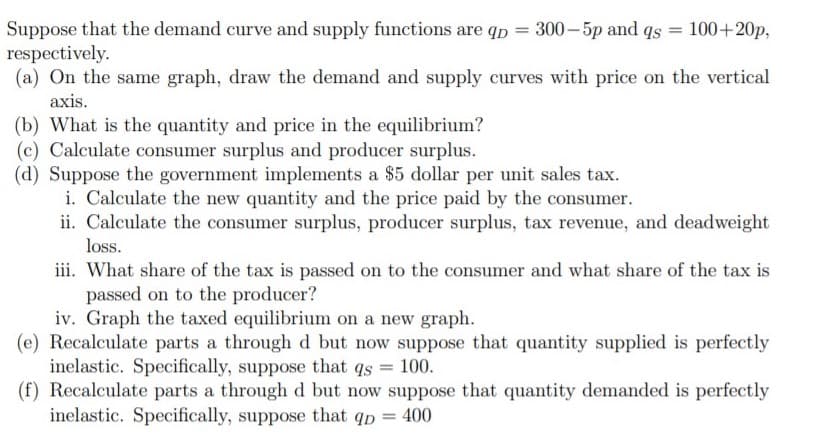Fuppose the government implements a $5 dollar per unit sales tax. i. Calculate the new quantity and the price paid by the consumer. ii. Calculate the consumer surplus, producer surplus, tax revenue, and deadweight loss. ii. What share of the tax is passed on to the consumer and what share of the tax is passed on to the producer? iv. Graph the taxed equilibrium on a new graph.
Fuppose the government implements a $5 dollar per unit sales tax. i. Calculate the new quantity and the price paid by the consumer. ii. Calculate the consumer surplus, producer surplus, tax revenue, and deadweight loss. ii. What share of the tax is passed on to the consumer and what share of the tax is passed on to the producer? iv. Graph the taxed equilibrium on a new graph.
Microeconomics A Contemporary Intro
10th Edition
ISBN:9781285635101
Author:MCEACHERN
Publisher:MCEACHERN
Chapter16: Public Goods And Public Choice
Section: Chapter Questions
Problem 14PAE
Related questions
Question
Pls answer d,e,f

Transcribed Image Text:Suppose that the demand curve and supply functions are qp = 300– 5p and qs = 100+20p,
respectively.
(a) On the same graph, draw the demand and supply curves with price on the vertical
%3D
axis.
(b) What is the quantity and price in the equilibrium?
(c) Calculate consumer surplus and producer surplus.
(d) Suppose the government implements a $5 dollar per unit sales tax.
i. Calculate the new quantity and the price paid by the consumer.
ii. Calculate the consumer surplus, producer surplus, tax revenue, and deadweight
loss.
iii. What share of the tax is passed on to the consumer and what share of the tax is
passed on to the producer?
iv. Graph the taxed equilibrium on a new graph.
(e) Recalculate parts a through d but now suppose that quantity supplied is perfectly
inelastic. Specifically, suppose that qs = 100.
(f) Recalculate parts a through d but now suppose that quantity demanded is perfectly
inelastic. Specifically, suppose that qp = 400
%3D
Expert Solution
This question has been solved!
Explore an expertly crafted, step-by-step solution for a thorough understanding of key concepts.
Step by step
Solved in 5 steps with 1 images

Knowledge Booster
Learn more about
Need a deep-dive on the concept behind this application? Look no further. Learn more about this topic, economics and related others by exploring similar questions and additional content below.Recommended textbooks for you








